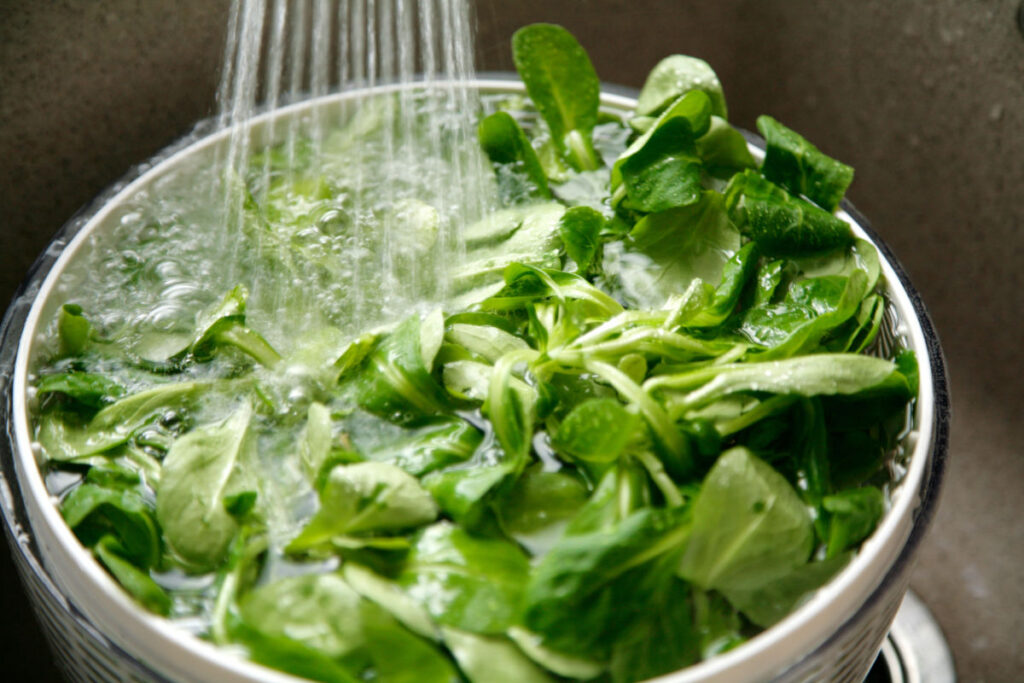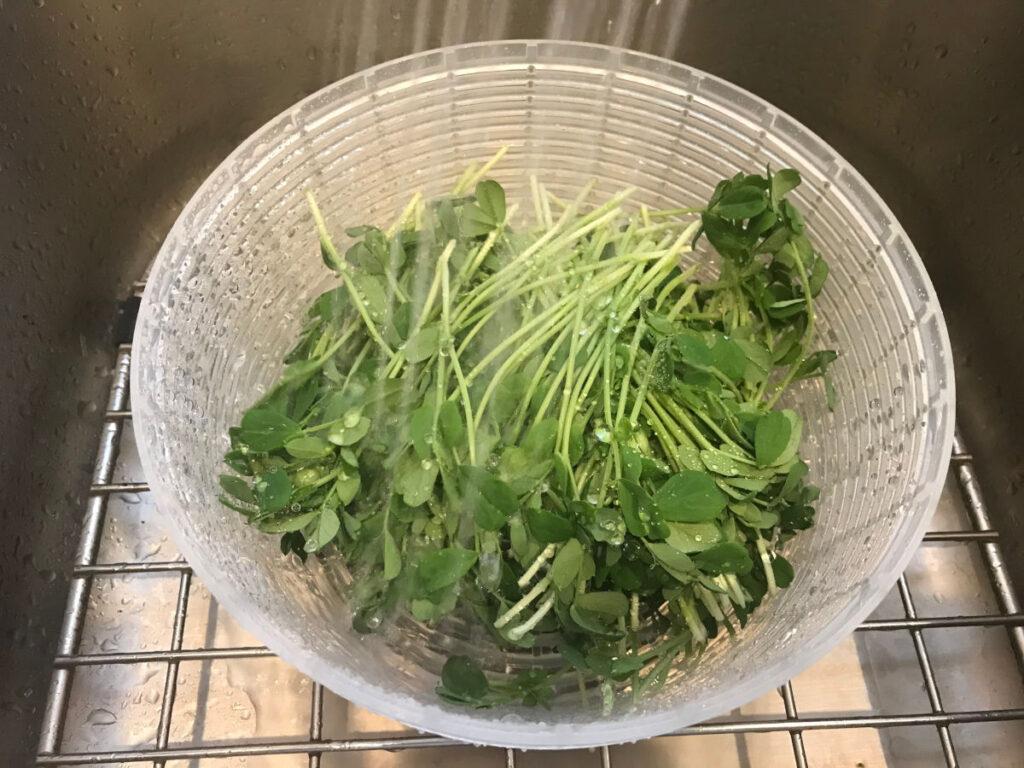I was surprised to hear from some of our customers that they don’t wash their sprouts and microgreens. I don’t think that’s a good practice, so I decided to write this article to explain why.
Do you have to wash microgreens? Yes you do. Just like any other produce or fruit, it’s prudent to wash microgreens before you eat them. There could be soil and seed hulls on the microgreens that can be easily cleaned with a quick rinse.
Some growers wash their microgreens before they package them while some don’t. Microgreens are very sensitive, and if you store them when they are wet, they will spoil much faster. Many growers don’t wash their microgreens, because they want their product to last longer in their customers’ possession. Others have developed a washing and drying method that they claim extends the shelf life of their microgreens. In addition, it may not be indicated on the packaging of your microgreens whether they were washed or not. So it is always good to check with the producer. If you buy your microgreen directly from the grower and the greens were freshly harvested and washed, that is the only time I would say it’s OK to eat them without washing them at home.
On the other hand, even if the microgreens have been washed, they could have been sitting on a store shelf for a few days before you purchased them. Grocery store shelves are not ideal for storing microgreens, because microgreens keep better in a cold, dark refrigerator. So in spite of the growers best practices of growing and washing, eventually bacteria could start growing inside the packaging. So it’s always safer to wash your microgreens before you eat them.
Why Do You Need to Wash Microgreens?
1. Soil
Microgreens are often grown in soil or soil-like growing media, such as coconut coir. Because microgreens are so close to the soil (as opposed to a tomato or cucumber) the soil particles can easily transfer to the stems and leaves during germination or watering.
For some reason, a portion of the population believes that eating small amounts of soil is OK because it provides beneficial organisms for your microbiome. That may be true, but it may also contain organisms that are not so beneficial for you. You don’t know what’s in the potting mix that the grower uses, but here are some common ingredients in “organic” potting soil: peat moss, coconut coir, worm castings, compost (this may include composted manure), perlite and vermiculite, organic fertilizer. If you want to know more about what else might be in potting soil, you can read our article on What Kind of Soil Do Microgreens Like.
Even if the soil is “organic” and the grower doesn’t use any chemicals, it’s best not to eat the soil. During the growing process, bacteria or fungi can grow in the soil that are invisible and harmless to the microgreens but that may be harmful to your health.
2. Microorganisms
Even if microgreens are grown in sterile soil, or soilless hydroponic growing media, during the growing process bacteria and fungi can also start to develop on the growing media and the plants themselves.
No matter how careful the grower is, it’s hard to create a completely sterile environment, so the microorganisms from the air can easily land on the growing trays. This is perfectly normal, but that’s why you should wash all your produce, including microgreens.
3. Seed Hulls
Certain microgreens have a hard time shedding their seed hulls, including sunflower, broccoli, kale, cabbage, and radish. Sunflower hulls are easy to see, so growers usually take care of removing those. But the seed hulls of the above mentioned brassicas are rather small, and some of them will end up among the harvested microgreens. It’s probably not a big deal if you eat a few of those, but remember that they grew out of soil, so they could still have tiny amounts of soil on them. A thorough rinse in a colander will wash away the small seed hulls.
How to Wash Microgreens

Microgreens need to be washed, but it’s best if you wash them just before you use them. They don’t last long when they are stored wet in the refrigerator.
1. Salad Spinner
The most effective way to wash microgreens is to use a salad spinner. Place the microgreens in the inner basket and hold the basket under running water in the sink. Use the spray head of your sink if you have one. Use cold water only. Warm or hot water can wilt your delicate microgreens. Watch for the seed hulls to fall through the basket. I like to wash them for at least 30 seconds to a minute.

Place the basket in the salad spinner bowl and spin it. It’s hard to say how long this will take. It depends on the type of salad spinner you have, but up to 30 seconds should be sufficient. I found that mine does a good job, but some of the microgreens won’t be completely dry. Especially the smaller, more delicate ones, such as broccoli, seem to retain more moisture than larger ones like sunflower or pea. So if your microgreens are not dry enough, you can pat them down with paper towels.
Depending on how I am going to use the microgreens, after spinning them I may place them on a paper towel, cover them with another paper towel and gently pat them down so that the paper towel absorbs most of the moisture. Make sure to use strong paper towels, otherwise if the wet paper towel starts tearing, it may be difficult to separate the microgreens. If you are drying large amounts of microgreens, you may need to do this more than once with another set of towels.
Now you are ready to use your microgreens. If you don’t use them all right away, you can place them in the fridge in an airtight container and use it the same day, or maybe the next day. But they won’t last much longer once they have been washed.
The difference between how you wash and dry your microgreens at home and how growers do it is very different. They often use large, high-speed spinners specifically designed for salad greens, and they use fans to dry the microgreens. Unless you recreate the same method at home, your washed microgreens will not last very long in the fridge.
2. Colander/Strainer
If you don’t own a salad spinner, or if you don’t feel like taking it out for a handful of microgreens, you can use a small colander or mesh strainer. The colander has larger holes, so seed hulls will be more easily removed than in a strainer.
Run the microgreens under cold water while turning over the microgreens with your hand. Then shake the colander to remove some of the water. Lay out a paper towel on your counter, dump the microgreens on the towel and cover and pat down with a second paper towel. With this method, you may need to use more paper towels than with the salad spinner method.
3. Bowl of Water
Some growers like to fill up a sink and put the microgreens in the sitting water. This works well for large amounts of microgreens. It’s more efficient than doing small batches in a colander. Then they gently move the microgreens around the water and then lift them out and strain and spin them. You can scale this process down by using a large bowl and filling it up with water.
One thing to keep in mind is that microgreens are delicate, some more than others. Sunflower greens are pretty tough, but broccoli, basil, and amaranth are more tender, so handle these carefully and don’t overspin or pat down too hard or you can crush them. Especially, if you are using the microgreens to garnish your dishes. You want them to stay intact, crisp and not limp and broken.
I hope I have convinced you that washing your microgreens is the prudent and safe thing to do, so that you can fully enjoy the wonderful nutritional benefits of microgreens without the danger of contamination.



Leave a Reply